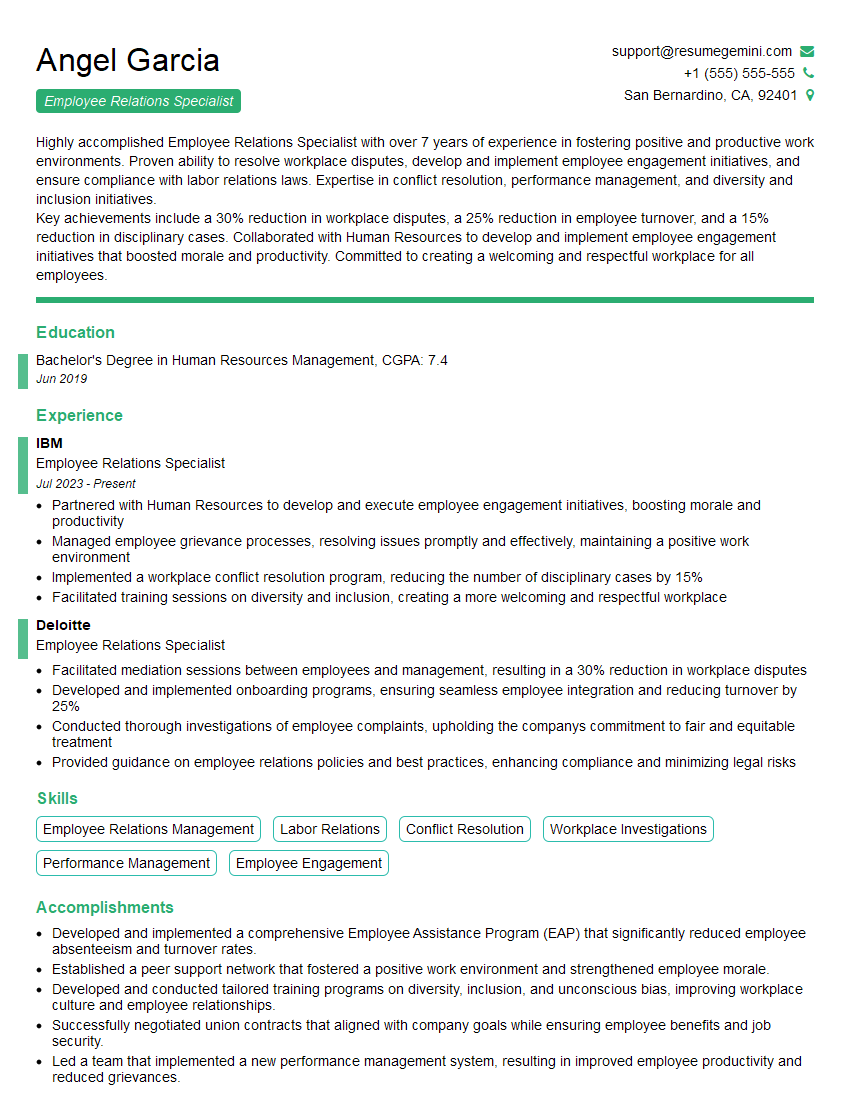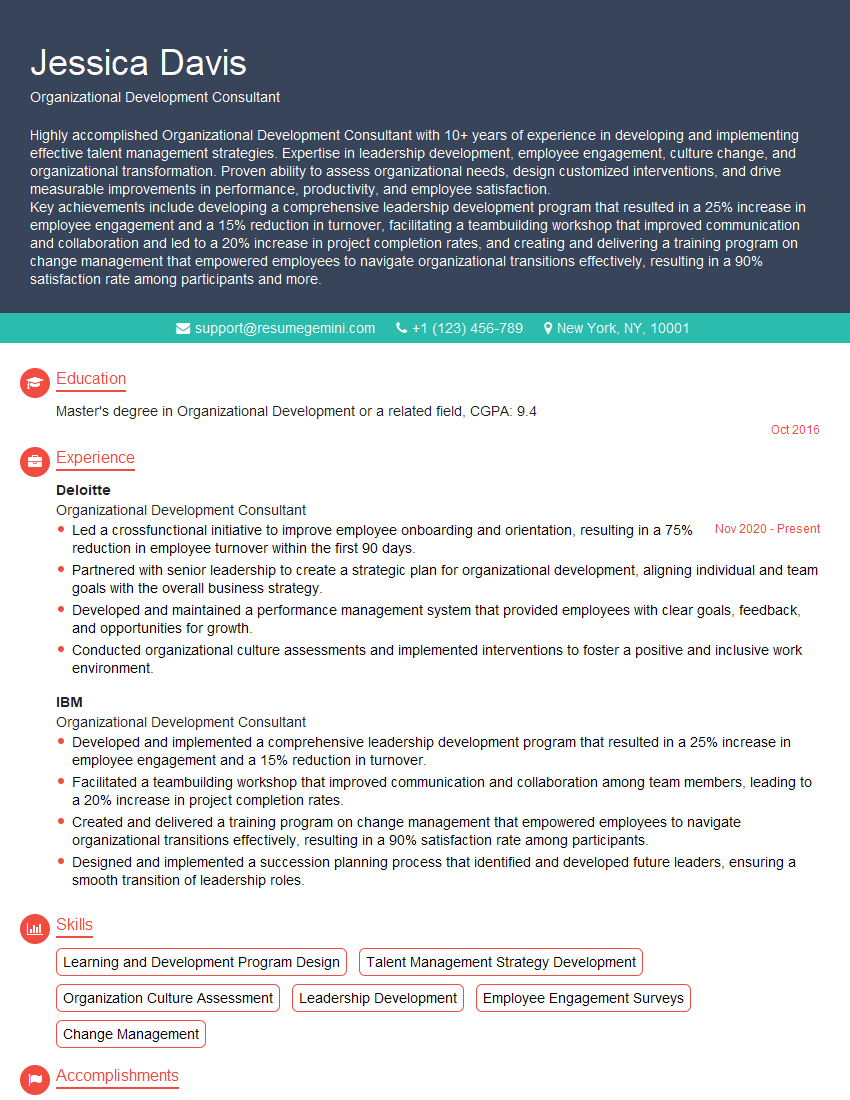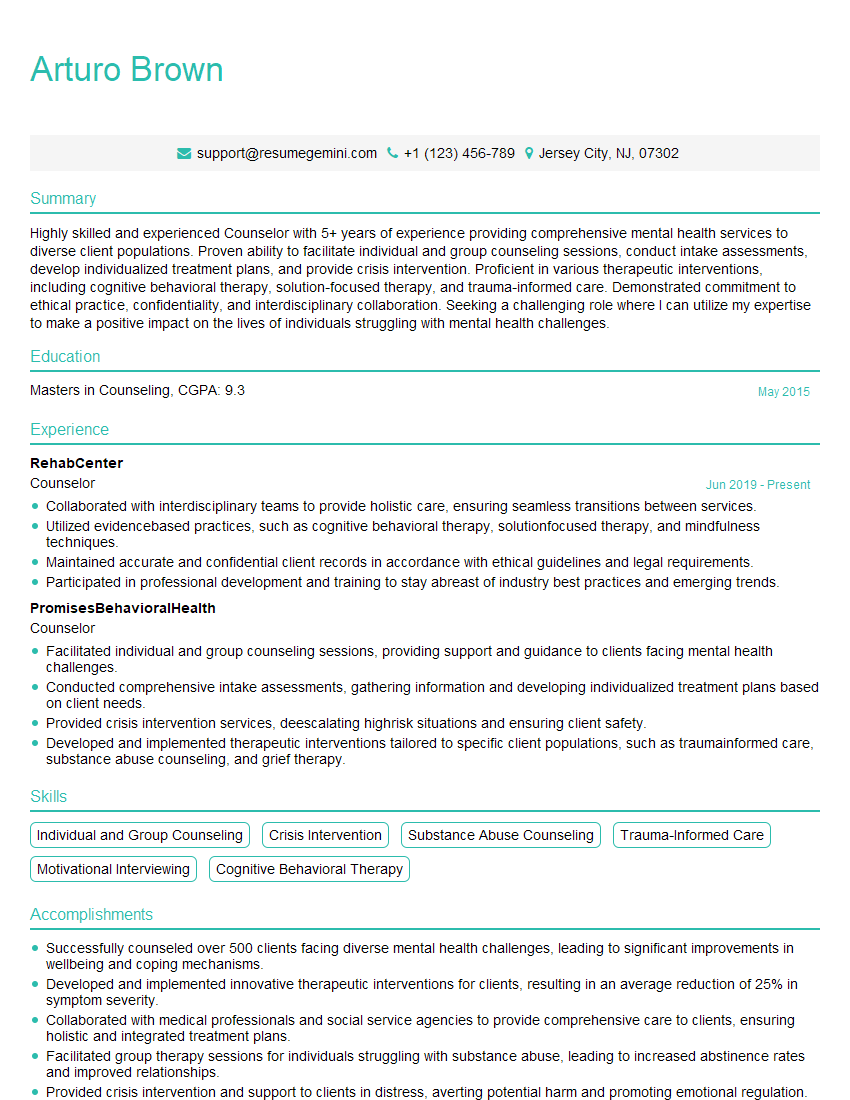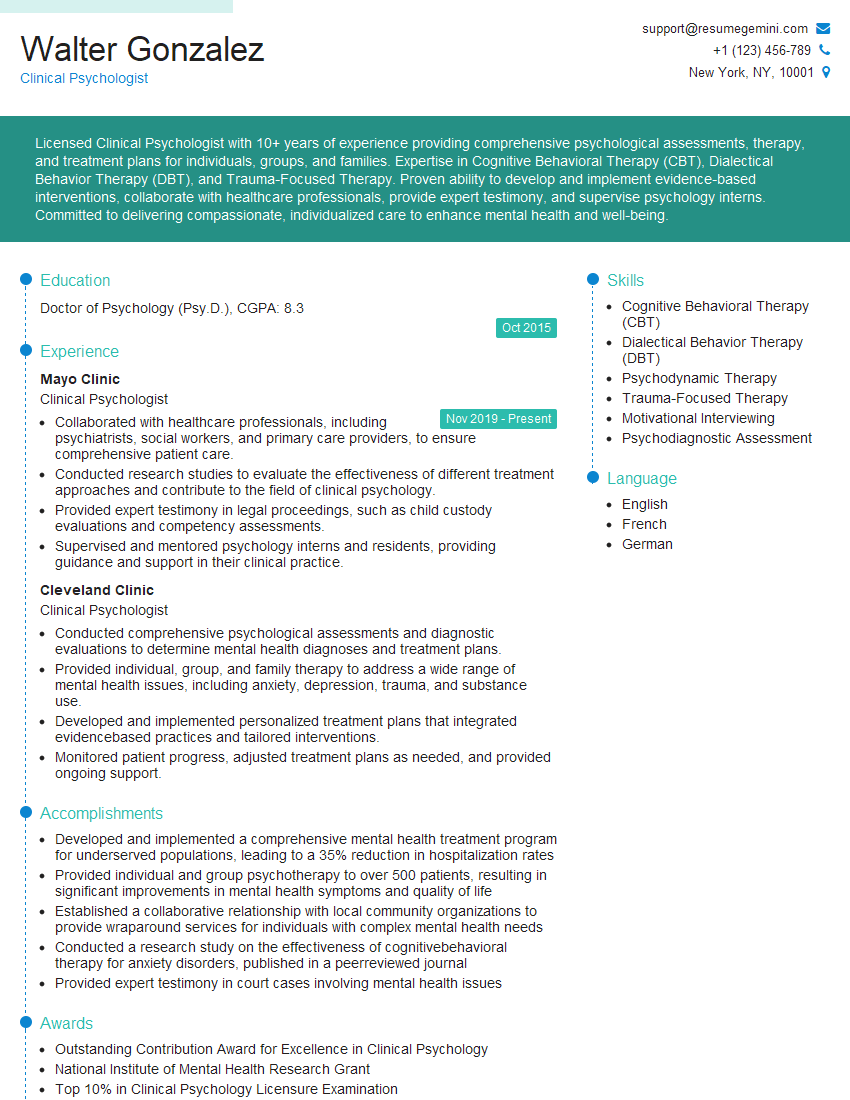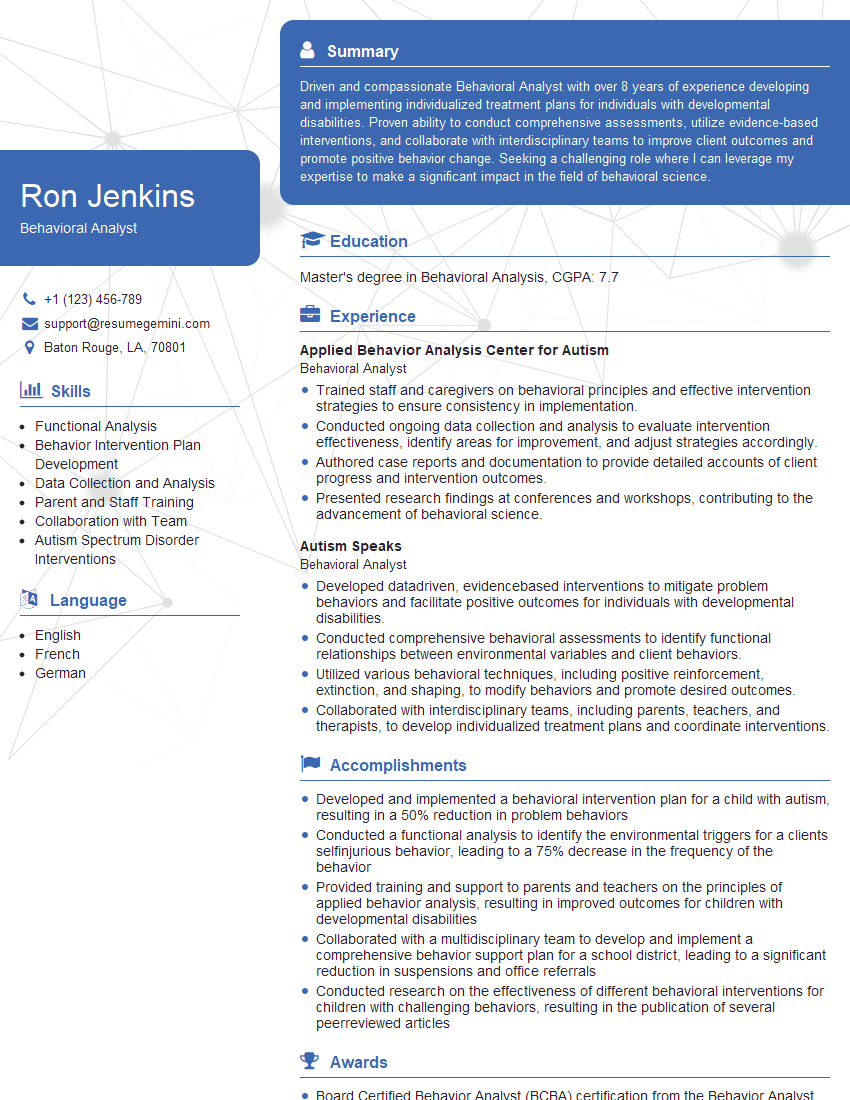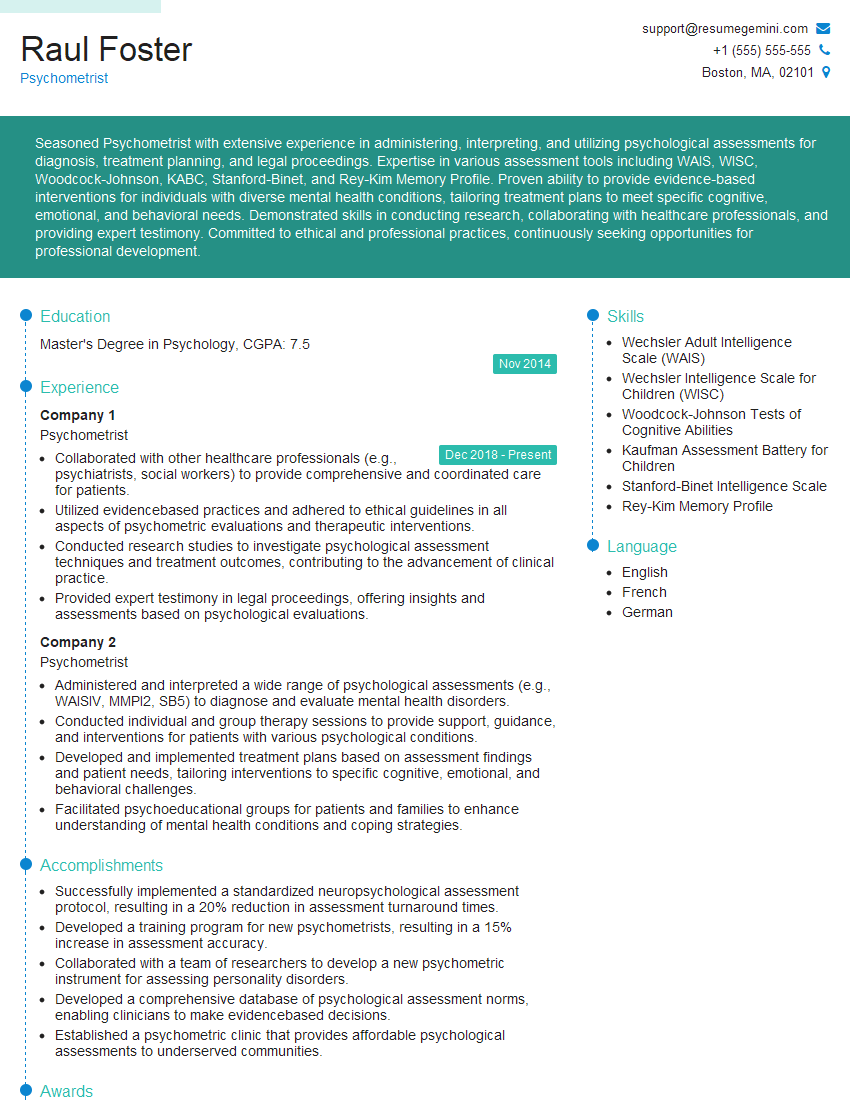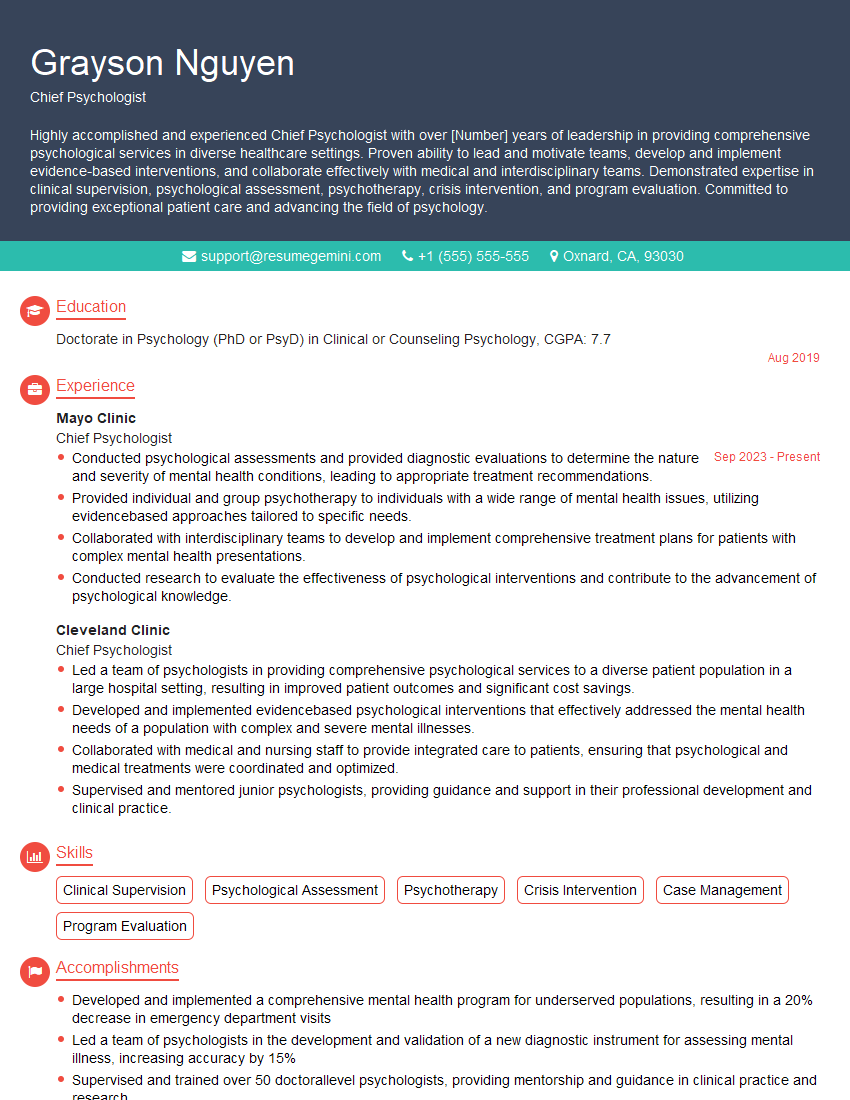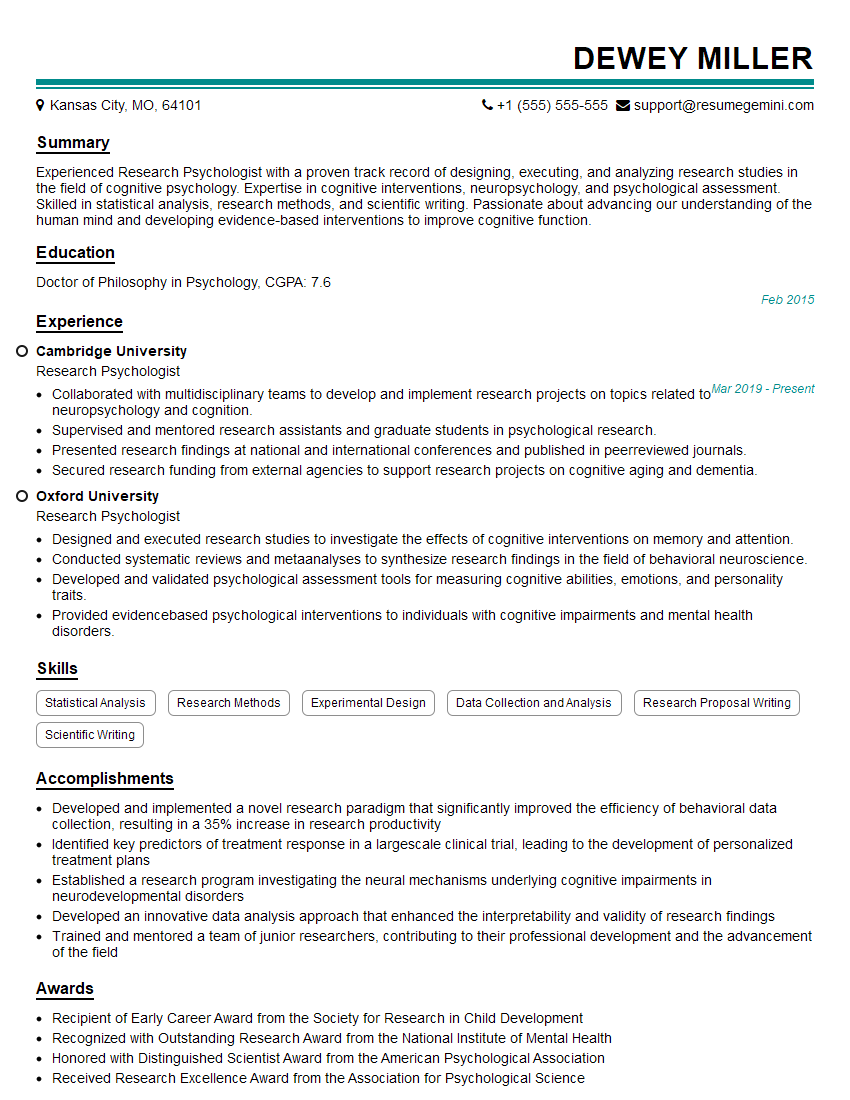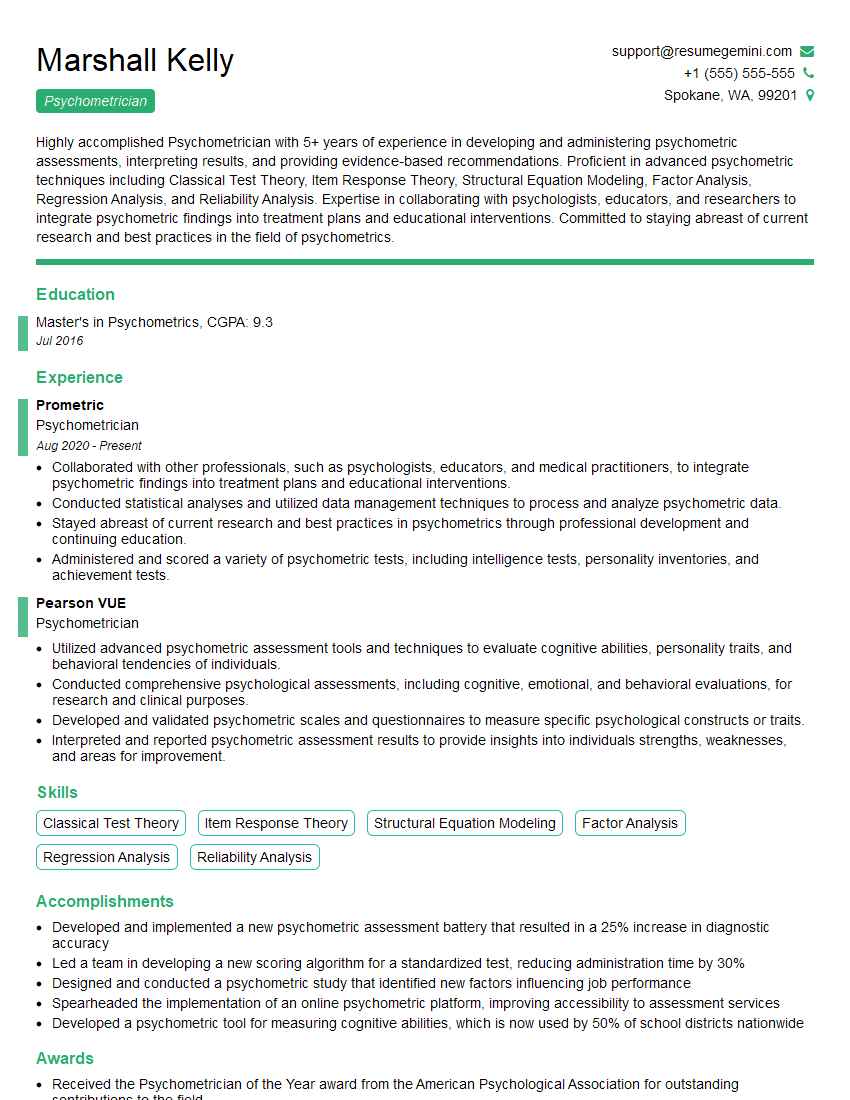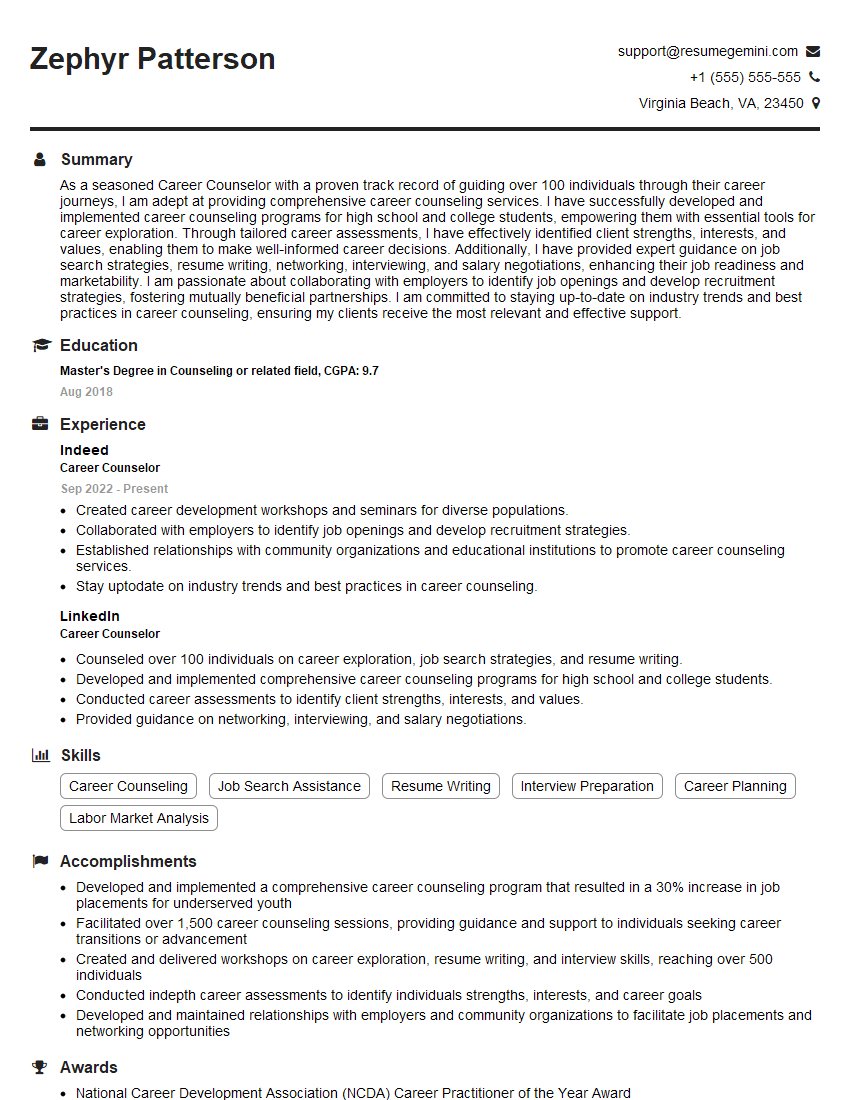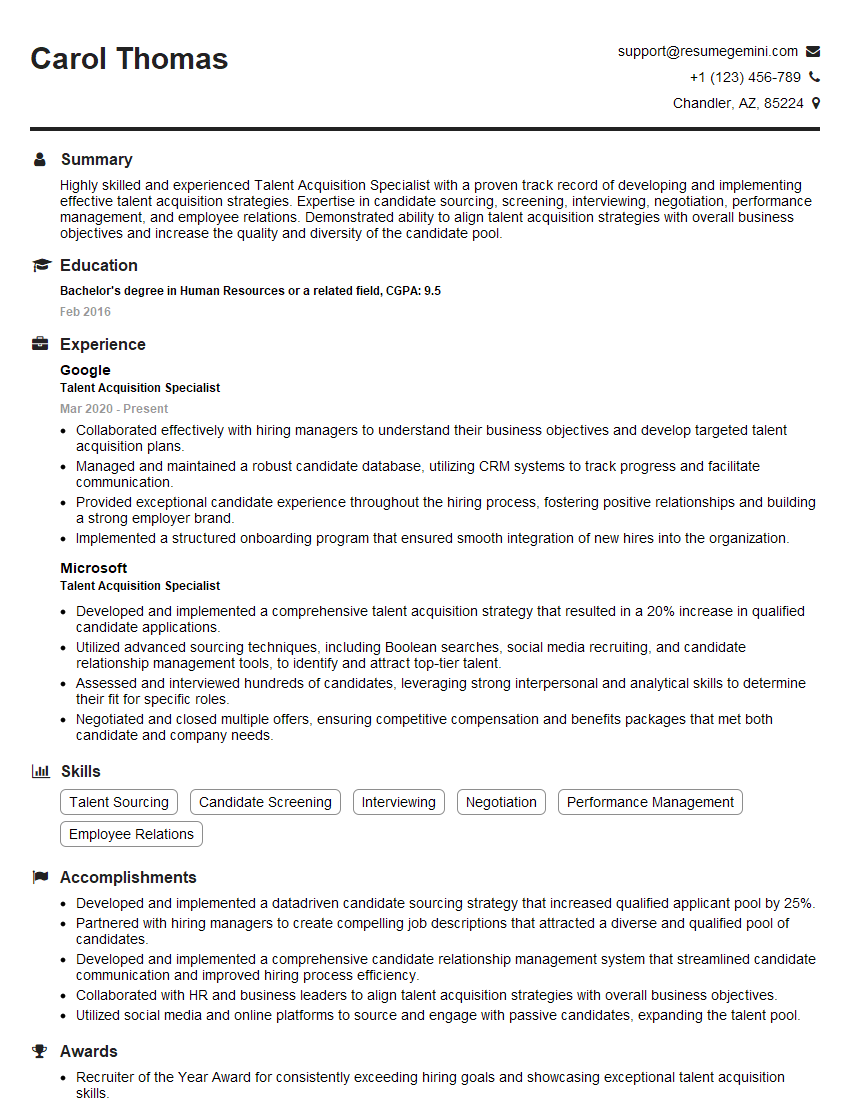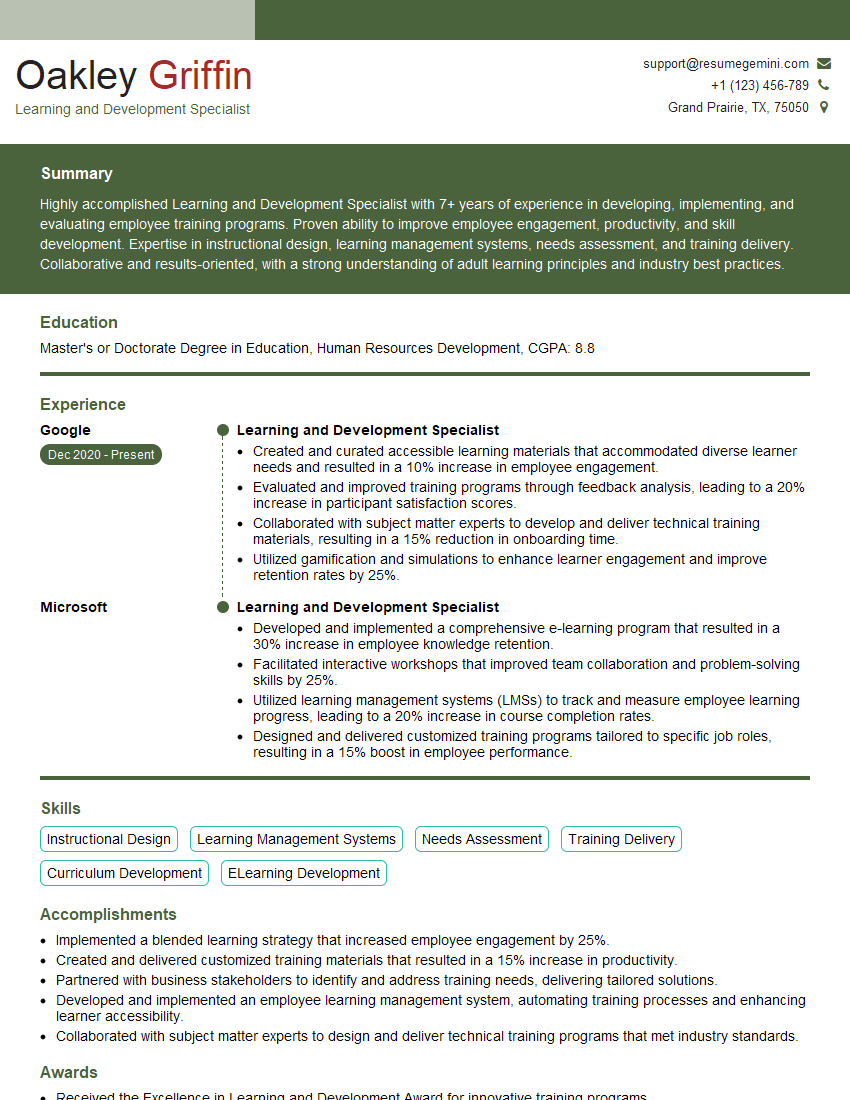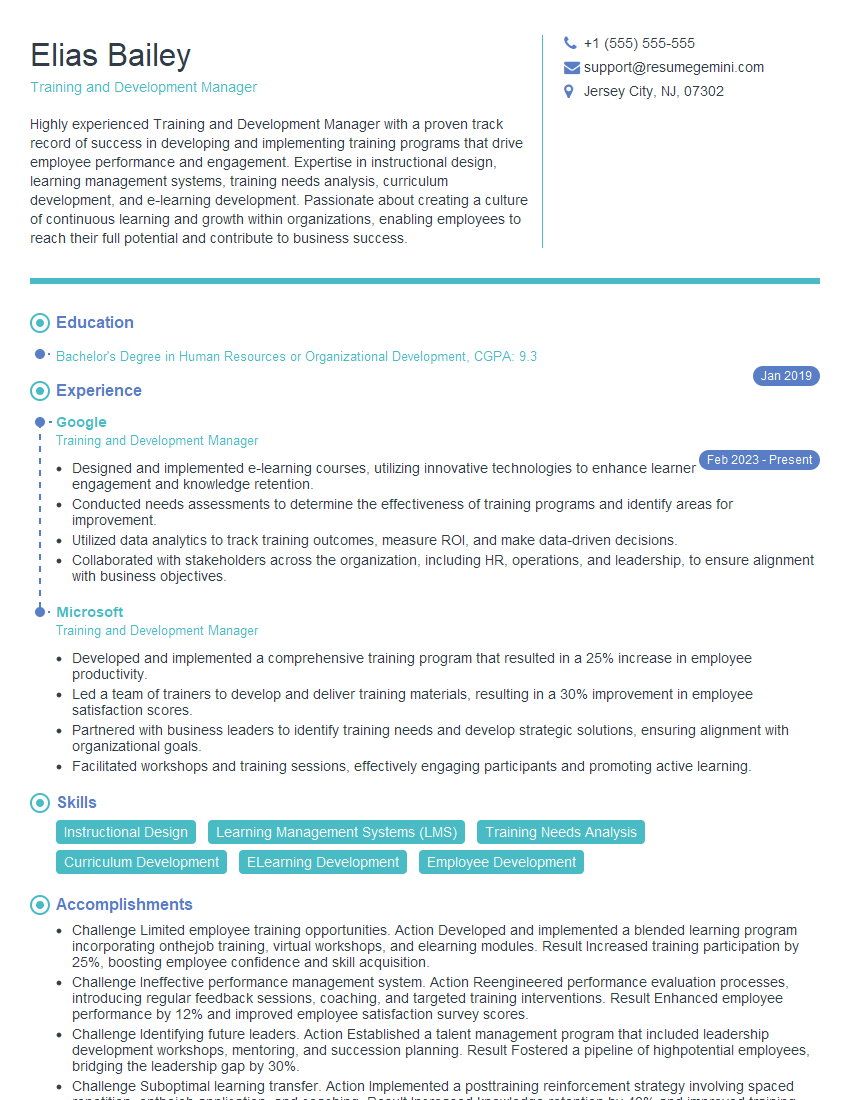Unlock your full potential by mastering the most common Personality Assessment and Interpretation interview questions. This blog offers a deep dive into the critical topics, ensuring you’re not only prepared to answer but to excel. With these insights, you’ll approach your interview with clarity and confidence.
Questions Asked in Personality Assessment and Interpretation Interview
Q 1. Explain the difference between objective and projective personality assessments.
Objective and projective personality assessments differ fundamentally in their approach to measuring personality. Objective assessments utilize structured, standardized questionnaires with a fixed set of response options, typically multiple-choice or Likert scales (e.g., strongly agree to strongly disagree). They aim for quantifiable, objective measures of personality traits. Think of a multiple-choice test where there’s only one ‘correct’ answer – in this case, the ‘correct’ answer is your honest response. Examples include the Minnesota Multiphasic Personality Inventory (MMPI) and the NEO Personality Inventory-Revised (NEO PI-R).
Projective assessments, on the other hand, present ambiguous stimuli – like inkblots (Rorschach) or pictures (Thematic Apperception Test, TAT) – to elicit responses that reveal unconscious thoughts, feelings, and motivations. The interpretation relies heavily on the clinician’s judgment and theoretical framework. It’s like asking someone to tell a story based on a vague image; their interpretation reveals aspects of their personality.
In essence, objective tests are like measuring height with a ruler – straightforward and quantifiable. Projective tests are like analyzing a painting – subjective and open to interpretation, revealing deeper, possibly hidden aspects of personality.
Q 2. Describe the strengths and limitations of the MMPI-2-RF.
The MMPI-2-RF (Minnesota Multiphasic Personality Inventory-2-Restructured Form) is a widely used objective personality assessment. Its strengths include its extensive normative data, improved psychometric properties compared to its predecessor (MMPI-2), and a more concise structure, reducing administration time. It provides scores on clinically relevant scales, allowing for a comprehensive assessment of personality pathology and related psychological functioning. For example, it can help identify individuals experiencing depression, anxiety, or antisocial tendencies.
However, the MMPI-2-RF also has limitations. It relies on self-report, making it susceptible to response biases like social desirability or malingering (faking good or bad). Its interpretation requires significant clinical expertise, and over-reliance on scores without considering other contextual information can lead to inaccurate conclusions. It may not be suitable for all populations, particularly those with limited reading abilities or cognitive impairments. Further, cultural biases may influence interpretations.
Q 3. What are the ethical considerations when administering personality assessments?
Ethical considerations in administering personality assessments are paramount. Informed consent is crucial – individuals must understand the purpose of the assessment, how the data will be used, and their right to withdraw at any time. Confidentiality must be maintained, protecting the client’s sensitive personal information. The results should be interpreted and communicated responsibly, avoiding jargon and ensuring the client understands the findings. It’s vital to avoid making diagnostic judgments based solely on assessment data; considering other information from the clinical interview and other assessment tools is critical.
Furthermore, clinicians must be competent to administer, score, and interpret the assessments they use, recognizing the limitations of any specific instrument. The chosen assessment should be appropriate for the client’s age, cultural background, and presenting concerns. Misusing an assessment, or employing one that is not appropriate for the client can cause harm.
Q 4. How do you ensure the validity and reliability of personality assessment results?
Ensuring the validity and reliability of personality assessment results is vital for accurate interpretation. Validity refers to whether the test measures what it intends to measure. Different types of validity exist, including content validity (does it cover the relevant aspects of personality?), criterion validity (does it correlate with other relevant measures?), and construct validity (does it measure the theoretical construct it’s designed to measure?).
Reliability, on the other hand, refers to the consistency of the test’s results. A reliable test will produce similar scores if administered multiple times to the same individual under similar conditions. We assess reliability through methods like test-retest reliability (consistency over time) and internal consistency (consistency of items within the test). To ensure both, it’s crucial to choose well-established tests with strong psychometric properties, follow standardized administration procedures, and be aware of potential sources of error, like respondent fatigue or inaccurate scoring.
For example, if a test consistently yields similar results over time (high test-retest reliability) and its items consistently measure the same underlying trait (high internal consistency), we can have more confidence in its accuracy.
Q 5. Describe your experience with different personality assessment instruments (e.g., Myers-Briggs, Big Five).
My experience encompasses a wide range of personality assessment instruments. I have extensive training and practical experience with objective measures like the MMPI-2-RF, NEO PI-R, and the 16PF (Sixteen Personality Factor Questionnaire). I’m also familiar with projective techniques like the Rorschach and TAT, although their interpretation requires a more nuanced approach due to their subjective nature.
While I have used and studied the Myers-Briggs Type Indicator (MBTI) and Big Five (often assessed through the NEO PI-R), my approach is cautious with the MBTI. While useful for broad personality exploration and self-awareness, its underlying psychometric properties are less robust compared to instruments like the NEO PI-R. The Big Five model, however, offers a strong theoretical framework and demonstrates excellent psychometric properties, making it a valuable tool in my practice.
My approach emphasizes using these tests in a holistic, case-specific way, considering the test results in conjunction with other relevant clinical information. No single test provides a complete picture of an individual’s personality.
Q 6. How do you interpret personality assessment results in the context of a job application?
Interpreting personality assessment results in a job application context requires a nuanced approach. The goal is not to use assessments to make hiring decisions alone, but to supplement other information, such as resumes, interviews, and work samples. Assessments can offer valuable insights into a candidate’s personality traits, work styles, and potential fit with the company culture.
For example, a candidate’s score on conscientiousness can indicate their attention to detail and organizational skills, which may be relevant for a meticulous role. However, it is crucial to avoid making assumptions based on a single trait. A score on a scale measuring neuroticism shouldn’t be interpreted as a direct measure of work performance. Instead, focus on how different traits might interact and contribute to overall job performance. Furthermore, it’s essential to consider legal and ethical implications and to ensure the assessment aligns with job-related requirements and avoids discrimination.
The emphasis should be on identifying candidates whose personality traits and work styles align with the job demands and organizational culture, not on identifying ‘perfect’ candidates.
Q 7. Explain the concept of construct validity and how it applies to personality assessments.
Construct validity is a crucial aspect of personality assessment, referring to the extent to which a test measures the theoretical construct (e.g., extraversion, neuroticism) it is designed to measure. It’s not about direct observation but about the extent to which a test successfully captures the underlying, unobservable psychological construct.
For instance, if a test claims to measure extraversion, it should demonstrate a strong correlation with other established measures of extraversion (convergent validity) and a weak correlation with measures of introversion (discriminant validity). It should also predict behaviors consistent with extraversion (predictive validity). Let’s say you are developing a test for measuring a new construct. To show construct validity, you should demonstrate that your test measures the qualities defined in your theoretical understanding of that construct.
Establishing construct validity involves multiple lines of evidence, including factor analysis, correlations with other related measures, and examination of the test’s ability to predict relevant behaviors or outcomes. A test with strong construct validity is more likely to be a meaningful and accurate measure of personality.
Q 8. How do you address test anxiety or response bias in personality assessments?
Addressing test anxiety and response bias in personality assessments is crucial for obtaining valid and reliable results. Test anxiety, the feeling of nervousness or apprehension during testing, can lead to inaccurate responses. Response bias, such as social desirability bias (responding in a way deemed socially acceptable), can also distort the outcome. To mitigate these issues, we employ several strategies:
- Creating a comfortable testing environment: This involves ensuring a quiet, private space with minimal distractions, and providing clear instructions and ample time to complete the assessment. A reassuring and supportive approach from the administrator is also key.
- Using instructions that minimize anxiety: Clearly explaining the purpose of the assessment, emphasizing that there are no right or wrong answers (for many personality tests), and stressing the importance of honest self-reporting can help alleviate anxiety.
- Incorporating validity scales: Many personality assessments include built-in scales designed to detect response bias, such as scales measuring social desirability, acquiescence (tendency to agree), or faking good/bad. These scales help identify individuals who may be responding in a non-genuine manner, allowing for a more nuanced interpretation of the results.
- Using multiple assessment methods: Combining personality tests with other assessment methods, such as interviews or behavioral observations, offers a more comprehensive and reliable understanding of an individual’s personality and minimizes the impact of single-method bias.
- Providing feedback and debriefing: A post-assessment discussion can help alleviate anxiety and clarify any misunderstandings. This allows the individual to discuss their responses and better understand the process.
For example, if a validity scale indicates a high level of social desirability bias, I would delve deeper into the individual’s responses, potentially using follow-up questions to explore the underlying reasons for those responses.
Q 9. Describe a situation where you had to explain complex assessment results to a non-technical audience.
I once had to explain the results of a Myers-Briggs Type Indicator (MBTI) assessment to a team of managers who were unfamiliar with personality typing. To make the results accessible, I avoided technical jargon and instead focused on practical implications for team dynamics. I explained each personality type using relatable analogies. For example, I described the ‘Extroverted Sensing’ (ES) preference as someone who is highly action-oriented and detail-focused, using the analogy of a skilled craftsman carefully crafting a product. I then linked these preferences to specific team roles and communication styles. The managers were able to easily grasp the concepts and apply the insights to improve team collaboration and individual performance. We discussed potential team challenges arising from personality differences and devised strategies for better teamwork, utilizing a simple visual representation of each team member’s personality type.
Q 10. How do you maintain confidentiality in personality assessment?
Maintaining confidentiality in personality assessment is paramount. It’s governed by ethical guidelines and often by legal regulations like HIPAA (in healthcare settings). My approach involves several key steps:
- Secure storage of assessment data: All assessment materials, including raw data, reports, and any identifying information, are stored securely, either physically in locked cabinets or electronically using password-protected, encrypted databases accessible only to authorized personnel.
- Anonymization or de-identification of data: Whenever possible, data is anonymized before analysis and reporting to remove any direct identifiers like names or social security numbers. This protects the individual’s identity while allowing for meaningful data analysis.
- Limited access to results: Access to assessment results is restricted to authorized individuals, usually only those directly involved in the assessment process and who have a legitimate need for the information. I always obtain informed consent before conducting assessments and clearly define who will have access to the results.
- Compliance with relevant regulations: I am always aware of and strictly adhere to all relevant legal and ethical guidelines concerning data privacy and confidentiality, including complying with relevant data protection laws, like GDPR.
- Data destruction: After the purpose of the assessment is fulfilled and the retention period is over, assessment data is securely destroyed according to established protocols.
Q 11. What are the legal implications of using personality assessments in hiring?
Using personality assessments in hiring carries significant legal implications. The primary concern is avoiding discrimination. The use of personality tests must align with equal employment opportunity (EEO) laws. Here’s a breakdown:
- Job relevance: Assessments must be job-related and consistent with business necessity. This means that the traits measured should be demonstrably relevant to successful performance in the specific job role. Using a test that measures traits irrelevant to the job is illegal and could lead to discrimination lawsuits.
- Validity and reliability: The assessment must be proven to be valid (measures what it claims to measure) and reliable (produces consistent results). The lack of evidence for validity and reliability creates legal vulnerabilities.
- Adverse impact: Assessments must not disproportionately screen out applicants from protected groups (e.g., based on race, gender, ethnicity, etc.). If the assessment shows adverse impact, organizations may need to justify its use and ensure that it is not discriminatory.
- Transparency and fairness: Applicants should be informed about the assessment’s purpose, and the results should be fairly considered alongside other relevant information.
Failing to adhere to these legal requirements can result in legal challenges, costly settlements, and reputational damage. Always ensure legal counsel is involved in the design and implementation of any personality assessment used in hiring.
Q 12. How do you ensure cultural fairness in the selection and use of personality tests?
Ensuring cultural fairness in personality assessments requires careful consideration of potential biases embedded within the test design, interpretation, and application. A culturally biased test will not accurately reflect the true personality traits of individuals from diverse cultural backgrounds.
- Test translation and adaptation: When using tests in different cultural settings, proper translation and adaptation are critical. A direct translation might not accurately capture the meaning and nuances of the original language, leading to misinterpretations. Adaptation goes beyond translation; it involves ensuring the test items are relevant and meaningful in the target culture.
- Cultural equivalence: Assessing whether the test constructs and scoring methods maintain equivalent meaning and interpretation across different cultures is essential. This involves careful examination of the items to ensure they are not culturally biased and that the scoring system doesn’t unfairly penalize individuals from certain cultural backgrounds.
- Norms and standardization: Tests must be standardized on diverse samples representative of the populations for which the test is intended. Norms established on one cultural group may not be applicable to others. A fair assessment needs culturally appropriate norms.
- Cultural sensitivity in interpretation: Interpreters need to understand and be sensitive to the cultural context of the individual’s responses. They should avoid making assumptions based on cultural stereotypes and seek to understand the individual’s behaviour within their cultural framework.
- Selecting culturally appropriate assessments: Prioritizing tests that have demonstrated cultural fairness and have been validated across various cultural groups is vital.
Q 13. What is your experience with using personality assessments for performance management?
I’ve used personality assessments extensively in performance management, particularly to enhance employee development and team building. They provide insights into individual strengths and weaknesses, communication styles, and potential areas for growth. This can inform goal setting, training needs, and leadership development programs. For example, understanding an employee’s preference for structure versus flexibility can help tailor their job responsibilities and performance expectations accordingly. By identifying potential blind spots or areas for improvement, targeted training and coaching can be provided to maximize their potential and boost overall team performance. Personality assessments also aid in creating more effective teams by highlighting communication styles and teamwork preferences; leading to better team cohesion and productivity.
However, it’s crucial to remember that personality assessments are just one piece of the puzzle in performance management. They should be used in conjunction with other performance indicators and qualitative feedback to create a holistic understanding of employee performance. Over-reliance on personality assessments alone is not best practice; they need to be used responsibly and ethically.
Q 14. Compare and contrast different personality assessment scoring methods.
Personality assessment scoring methods vary considerably, each with its strengths and weaknesses. Here’s a comparison:
- Normative Scoring: This method compares an individual’s score to the scores of a large, representative sample group (the norm group). The individual’s score is expressed as a percentile rank or a standard score (e.g., z-score, T-score), indicating their relative standing within the norm group. This is useful for comparing individuals, but the meaning of the scores is dependent on the characteristics of the norm group. For example, a high score on extroversion might mean very different things depending on whether the norm group consisted of predominantly introverted or extroverted individuals.
- Ipsative Scoring: This method focuses on an individual’s unique profile rather than comparing them to others. It doesn’t produce normative data. Individuals rate the importance or frequency of certain traits relative to each other. For example, an individual might rate “conscientiousness” higher than “agreeableness” in their self-assessment. This is useful for understanding an individual’s internal priorities and values, but makes direct comparison between individuals difficult. It also potentially downplays the overall strength of personality traits.
- Criterion-Referenced Scoring: This method focuses on measuring an individual’s performance against a predetermined standard or criterion. Instead of comparison to a norm group, it determines whether the individual meets a specific level of proficiency in different traits or skills relevant to a particular job or role. For instance, a score indicating a specific competency level is provided for a particular job function, rather than a percentile rank.
The choice of scoring method depends on the purpose of the assessment. Normative scoring is often preferred when comparing individuals, while ipsative scoring is suitable for understanding individual priorities. Criterion-referenced scoring is suitable for measuring attainment of a specific skill or competency level.
Q 15. How do you handle discrepancies between self-report and observed behaviors in personality assessment?
Discrepancies between self-report and observed behavior in personality assessments are common and crucial to address. They highlight the limitations of relying solely on self-reported data, which can be influenced by social desirability bias, self-deception, or a lack of self-awareness. The key is to triangulate information from multiple sources.
- Investigate the Discrepancy: First, carefully examine the specific discrepancies. Is it a minor difference or a significant clash? What aspects of the self-report and observed behavior differ? For example, a candidate might score highly on conscientiousness in a self-report measure, yet consistently miss deadlines. This requires further investigation.
- Consider Contextual Factors: Analyze the context in which the behaviors were observed. Was the individual under stress? Were there unusual circumstances? A normally organized person might display disorganized behavior during a highly stressful situation.
- Gather Additional Data: Employ multiple assessment methods. Include behavioral observations, interviews, and potentially, peer ratings. This helps create a more holistic picture and reduces reliance on a single data point.
- Integrative Approach: Don’t simply dismiss self-report data. Instead, consider it alongside other information to form a comprehensive understanding. The observed behavior might be more indicative of current situational performance, while self-report might reflect long-term personality tendencies.
- Qualitative Data: Qualitative data from interviews can provide crucial context and insights into the reasons behind discrepancies. For instance, a direct conversation might reveal that a candidate’s self-reported low self-esteem is a result of past experiences and not a reflection of current capabilities.
Ultimately, the goal is to understand the individual’s personality in a nuanced way, acknowledging the influence of both dispositional traits and situational factors.
Career Expert Tips:
- Ace those interviews! Prepare effectively by reviewing the Top 50 Most Common Interview Questions on ResumeGemini.
- Navigate your job search with confidence! Explore a wide range of Career Tips on ResumeGemini. Learn about common challenges and recommendations to overcome them.
- Craft the perfect resume! Master the Art of Resume Writing with ResumeGemini’s guide. Showcase your unique qualifications and achievements effectively.
- Don’t miss out on holiday savings! Build your dream resume with ResumeGemini’s ATS optimized templates.
Q 16. Describe your experience with norm-referenced vs. criterion-referenced assessments.
Norm-referenced and criterion-referenced assessments serve different purposes in personality evaluation. Norm-referenced tests compare an individual’s score to a larger group (the norm group), providing a percentile rank or standard score. Criterion-referenced tests, on the other hand, assess performance against a predetermined standard or criterion, rather than comparing to others.
- Norm-Referenced: Think of a standardized IQ test. Your score isn’t just a raw number; it’s compared to the scores of thousands of others, allowing us to see where you stand relative to the average. This is great for identifying individuals who are exceptionally high or low on a particular trait, but it doesn’t tell us about a specific skill level.
- Criterion-Referenced: A driving test is a good example. You aren’t compared to other drivers; you’re evaluated on whether you meet a specific set of criteria (e.g., successfully completing a three-point turn, maintaining lane position). This is useful for assessing proficiency in a particular area.
In personality assessment, norm-referenced tests like the Big Five Inventory (BFI) provide a profile relative to the general population, indicating where someone scores on different traits like extraversion or neuroticism. Criterion-referenced approaches might be used to assess if a candidate possesses the specific personality characteristics needed for a job, defined by specific behavioral criteria. The choice depends on the assessment goals.
Q 17. What are some common biases in personality assessments and how can they be mitigated?
Personality assessments, like all psychological tools, are susceptible to various biases. Understanding and mitigating these biases is crucial for accurate interpretation.
- Response Bias: This encompasses various tendencies such as social desirability bias (presenting oneself in a favorable light), acquiescence bias (agreeing with statements regardless of content), and extreme responding (choosing extreme response options). Techniques to mitigate these include using reverse-scored items, forced-choice questions, and incorporating validity scales to detect response biases.
- Cultural Bias: Assessment tools developed in one culture might not be equally valid or reliable in another due to differences in values, norms, and expression of personality. Adapting assessments for cultural contexts or using culturally sensitive measures is vital. Translations alone are insufficient; cultural equivalence must be ensured.
- Interviewer Bias: During interviews, interviewers’ expectations or personal biases can influence their perceptions of the candidate. Structured interviews with standardized questions and scoring reduce this bias.
- Test Bias: The test itself might inadvertently favor certain groups over others. For example, a test written in a specific dialect might disadvantage individuals who are not fluent in it. Thorough psychometric evaluations, including examining item response theory analyses, are needed to identify and address test bias.
Mitigating bias requires careful test selection, utilizing appropriate statistical analysis, and employing culturally sensitive administration and interpretation procedures. Ongoing evaluation and refinement of assessment methods are essential.
Q 18. How would you explain the concept of personality traits to a job candidate?
Imagine your personality as a collection of consistent patterns in your thoughts, feelings, and behaviors. These patterns are called traits. Some common traits include extraversion (how outgoing you are), conscientiousness (how organized and dependable you are), agreeableness (how cooperative and friendly you are), neuroticism (how prone you are to anxiety and negative emotions), and openness to experience (how curious and imaginative you are).
These traits aren’t labels; they describe tendencies. For instance, being high in extraversion doesn’t mean you’re always outgoing, just that you tend to be more so than someone low in extraversion. Understanding your personality traits can help you understand your strengths, weaknesses, and how you interact with the world. In the workplace, this understanding can contribute to improved teamwork, productivity, and job satisfaction.
Q 19. Discuss the importance of considering individual differences when interpreting personality assessments.
Individual differences are paramount in personality assessment interpretation. Ignoring these variations can lead to inaccurate and unfair judgments. No two individuals are exactly alike, and their personality profiles should be understood within their unique contexts.
- Life Experiences: Past experiences shape personality. Trauma, significant life events, and upbringing profoundly influence an individual’s behavior and emotional responses.
- Cultural Background: Cultural norms and expectations impact how personality traits are expressed and perceived. A behavior considered assertive in one culture might be seen as aggressive in another.
- Developmental Stage: Personality continues to develop throughout life. Interpretations must consider the individual’s age and developmental stage.
- Motivational Factors: An individual’s goals, needs, and motivations can influence their behavior in ways that might not be directly reflected in personality scores. For example, a highly motivated person might exhibit different behaviors than a less motivated individual, even if their underlying personality traits are similar.
A comprehensive interpretation acknowledges these individual differences and avoids generalizing based solely on personality scores. It integrates information from multiple sources and considers the overall context of the individual’s life.
Q 20. What is your understanding of the impact of personality on job performance?
The relationship between personality and job performance is complex but significant. Research suggests that certain personality traits are associated with better performance in specific roles. For example, conscientiousness consistently predicts higher job performance across various occupations. Extraversion is often linked to success in sales and leadership positions. Emotional stability (low neuroticism) is crucial in high-stress environments.
However, it’s crucial to remember that personality is only one piece of the puzzle. Other factors such as skills, experience, and motivation also play crucial roles. A high level of conscientiousness won’t compensate for a lack of necessary skills. Additionally, the impact of personality traits can vary depending on the specific job demands and organizational culture.
For example, high levels of agreeableness might be beneficial in customer service roles, but could be less advantageous in highly competitive environments. Therefore, a nuanced understanding of the job requirements and the organizational context is necessary to appropriately interpret the relevance of personality traits in predicting job success.
Q 21. How would you assess the suitability of a specific personality test for a particular job role?
Selecting the right personality test for a specific job role involves a systematic process that considers several factors.
- Job Analysis: Begin with a thorough job analysis to identify the key competencies, skills, and personality traits required for successful performance. This might involve interviewing current employees, reviewing job descriptions, and observing employees in action.
- Test Validity and Reliability: Examine the psychometric properties of various personality tests. Ensure the test has demonstrated validity (accurately measures what it claims to measure) and reliability (provides consistent results) specifically for the type of job being considered.
- Test Suitability: Consider the test’s length, format, and administration method. Is it suitable for the candidate pool’s literacy level and cultural background? An overly lengthy or complex test might discourage participation or yield inaccurate results.
- Legal and Ethical Considerations: Adhere to legal and ethical guidelines. Ensure that the chosen test doesn’t discriminate against any protected groups. Transparency about the purpose of the assessment is also crucial.
- Practical Considerations: Consider the cost, time constraints, and availability of qualified personnel to administer and interpret the test.
Once a test is selected, it’s essential to use the results cautiously, in conjunction with other assessment methods such as interviews and work samples, to arrive at a holistic and unbiased evaluation.
Q 22. Describe your experience with using personality assessments in team-building or leadership development.
Personality assessments are invaluable tools in team-building and leadership development. I’ve extensively used instruments like the Myers-Briggs Type Indicator (MBTI) and the Big Five personality traits (OCEAN) to foster effective team dynamics and identify leadership potential. In one project, we used the MBTI to understand team member communication styles within a marketing department. By identifying individuals’ preferences (e.g., introverted vs. extroverted, sensing vs. intuitive), we were able to tailor communication strategies, leading to improved collaboration and project outcomes. For leadership development, we leveraged the Big Five to assess candidates’ openness to experience, conscientiousness, extraversion, agreeableness, and neuroticism. This helped identify individuals with the potential for strong leadership, specifically focusing on traits like conscientiousness and emotional stability, which correlate with effective leadership performance. Understanding these personality traits enables targeted training programs focused on strengthening existing strengths and developing areas for improvement.
For example, a team lacking in collaborative spirit (low agreeableness scores) could benefit from team-building exercises focused on conflict resolution and shared goal setting. Similarly, identifying leaders with high neuroticism might indicate a need for stress management training to improve their resilience.
Q 23. How do you manage the challenges of integrating personality assessment data with other selection methods?
Integrating personality assessment data with other selection methods is crucial for a comprehensive and unbiased evaluation. I typically avoid relying solely on personality tests. Instead, I combine them with structured interviews, work sample tests, and background checks. This multifaceted approach minimizes the risk of bias inherent in any single assessment method. Personality assessments provide valuable insights into an individual’s potential and work style but do not directly measure skills or past performance.
For example, a candidate might score highly on conscientiousness (a valuable trait), but a work sample test reveals a deficiency in specific technical skills. By integrating data from various methods, I gain a complete picture of the candidate’s suitability for the role. This holistic approach improves the accuracy and predictive validity of the selection process. It also provides a more robust defense against legal challenges by demonstrating a comprehensive and fair evaluation.
Q 24. Explain your understanding of the concept of predictive validity in personality assessment.
Predictive validity in personality assessment refers to the extent to which a test accurately predicts future behavior or job performance. A test with high predictive validity indicates that scores obtained on the test accurately reflect real-world outcomes. For example, a personality test designed to predict job success should demonstrate a strong correlation between test scores and actual on-the-job performance ratings. This is determined through rigorous statistical analyses, often comparing scores against actual performance metrics over a specific period.
Establishing predictive validity requires a well-defined criterion (e.g., job performance ratings, sales figures) and a large, representative sample of individuals. Longitudinal studies are often needed to track individuals over time and determine the accuracy of the predictions. Low predictive validity suggests that the assessment may be inaccurate or irrelevant for predicting the targeted behavior, necessitating a review of the assessment’s design or the choice of assessment tool.
Q 25. What is your preferred method for providing feedback on personality assessment results?
My preferred method for providing feedback on personality assessment results involves a structured, personalized approach, emphasizing a collaborative and developmental perspective. I avoid simply presenting a list of traits or scores. Instead, I initiate a conversation where I explain the purpose of the assessment, the process used, and the limitations of the results. Then, I translate the assessment data into actionable insights, focusing on strengths, areas for development, and potential work style implications.
I use clear, non-technical language, ensuring the individual understands their results and how they might impact their work. I always emphasize that personality assessments are not definitive labels but tools for self-understanding and growth. The feedback session focuses on empowering the individual to use the results to improve their performance and navigate their career more effectively. Following the session, I provide a written summary of the key findings and recommendations as a reference point.
Q 26. How do you stay current with the latest research and best practices in personality assessment?
Staying current in personality assessment requires continuous professional development. I achieve this through several avenues. I regularly attend conferences and workshops offered by organizations like the Society for Industrial and Organizational Psychology (SIOP). This keeps me abreast of new research findings and best practices. I also subscribe to leading journals in the field, such as the Journal of Applied Psychology and the Journal of Personality and Social Psychology. Further, I actively participate in online professional networks and communities, engaging in discussions and sharing knowledge with fellow practitioners. Finally, I regularly review and update my knowledge of the latest versions and updates of frequently used assessment instruments to ensure accuracy and relevance.
Q 27. Describe a time you had to troubleshoot a problem with a personality assessment instrument.
During a large-scale leadership assessment project, we encountered a problem with an online personality assessment platform experiencing technical difficulties. The platform was unavailable for several hours, impacting our project timeline. My initial troubleshooting steps involved contacting the platform’s technical support team. Simultaneously, we explored contingency plans, which included using alternative methods for data collection, like paper-and-pencil assessments. Through a series of collaborative efforts, the platform issue was resolved, and the technical support team provided a detailed report on the causes of the malfunction. This experience reinforced the importance of having backup plans and effectively communicating with vendors to minimize the impact of unexpected technical glitches.
Q 28. How would you handle a situation where a candidate questions the fairness or relevance of a personality test?
If a candidate questions the fairness or relevance of a personality test, I address their concerns with empathy and transparency. I start by acknowledging their perspective and validating their feelings. I explain the purpose of the assessment in the selection process, emphasizing that it’s one piece of a larger evaluation, not the sole determinant. I clearly explain how the assessment data is used (only to identify work styles and potential, not to judge character). It’s essential to highlight the importance of the assessment in understanding work preferences and potential fit with the organizational culture. I would also be prepared to discuss the test’s psychometric properties (validity and reliability), demonstrating its professional standards and the efforts to minimize bias.
Should the candidate remain unconvinced, I would consider alternative methods to gather relevant information. For example, a more in-depth behavioral interview focused on specific work situations might better address the candidate’s concerns. The goal is to build trust and maintain a positive candidate experience. It is crucial to respect the individual’s feelings while adhering to established professional and ethical practices. This demonstrates a commitment to fairness and demonstrates respect for the candidate.
Key Topics to Learn for Personality Assessment and Interpretation Interview
- Major Personality Theories: Understand the foundational principles and applications of prominent theories like the Big Five (OCEAN), Myers-Briggs Type Indicator (MBTI), and other relevant models. Be prepared to discuss their strengths, limitations, and appropriate applications.
- Assessment Instrument Selection & Administration: Discuss the criteria for choosing the right personality assessment based on context, purpose, and population. Demonstrate knowledge of ethical considerations and best practices in administering and scoring these instruments.
- Interpretation and Report Writing: Master the art of interpreting assessment results accurately and translating complex data into clear, concise, and actionable reports for clients or stakeholders. Practice synthesizing findings and providing insightful recommendations.
- Practical Applications in Various Settings: Showcase your understanding of how personality assessments are used in different fields, such as hiring, team building, leadership development, career counseling, and clinical settings. Provide examples of how you would apply your knowledge in each scenario.
- Validity, Reliability, and Bias in Assessment: Critically evaluate the psychometric properties of personality assessments. Discuss issues of validity, reliability, cultural bias, and potential limitations in interpretation. Be ready to address these considerations ethically and professionally.
- Data Analysis and Statistical Concepts: Demonstrate familiarity with basic statistical concepts relevant to personality assessment, such as correlations, standard deviations, and percentiles. Show your ability to interpret statistical data to support your interpretations.
- Ethical and Legal Considerations: Highlight your awareness of ethical guidelines and legal implications related to the use and interpretation of personality assessments, including issues of confidentiality and informed consent.
Next Steps
Mastering Personality Assessment and Interpretation opens doors to diverse and rewarding career paths, offering opportunities for professional growth and impact. A strong resume is crucial for showcasing your skills and experience to prospective employers. To significantly enhance your job prospects, focus on creating an ATS-friendly resume that highlights your relevant qualifications. We strongly recommend using ResumeGemini to build a professional and impactful resume that catches the attention of recruiters. ResumeGemini offers valuable tools and resources, including examples of resumes tailored specifically to Personality Assessment and Interpretation, helping you present yourself effectively and land your dream job.
Explore more articles
Users Rating of Our Blogs
Share Your Experience
We value your feedback! Please rate our content and share your thoughts (optional).
What Readers Say About Our Blog
This was kind of a unique content I found around the specialized skills. Very helpful questions and good detailed answers.
Very Helpful blog, thank you Interviewgemini team.
